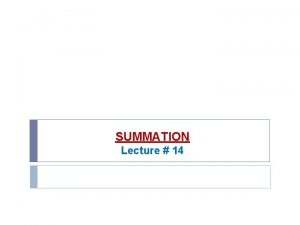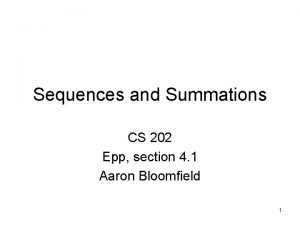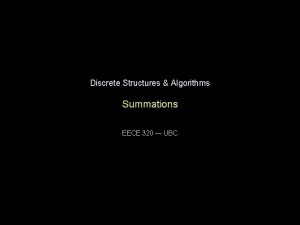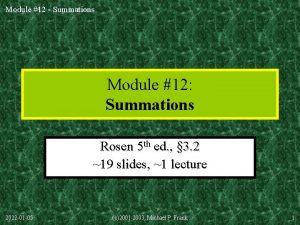Section 5 2 Summations and Closed Forms A






- Slides: 6

Section 5. 2 Summations and Closed Forms A closed form is an expression that can be computed by applying a fixed number of familiar operations to the arguments. For example, the expression 2 + 4 + … + 2 n is not a closed form, but the expression n(n+1) is a closed form. Summation Notation: Summation Facts (1) (2) (3) (4) (5) Collapsing Sums) Some Useful Closed Forms (1) (2) (3) (4) (5) 1

Example. Find a closed form for the expression Solution: (Fact 4) (Fact 3) (Form 5) Example. Find a closed form for Solution: The sum has the form (Fact 1) (Fact 4) (Fact 3) (Form 5) 2

Quiz. Use summation facts and forms to prove that Solution. Quiz. Use summation facts and forms to find a closed form for Solution. 3

Example. Let count(n) be the number of : = statements executed by the following algorithm as a function of n, where n N. Find a closed form for count(n). i : = 1; (1) while i < n do i : = i + 1; (n – 1) for j : = 1 to i do S od (2 + 3 + … + n) od The expressions in parentheses indicate the number of times that : = is executed. Therefore, count(n) is the sum: Quiz. Let count(n) be the number of executions of S in the preceding algorithm as a function of n. Find a closed form for count(n). Solution. 4

Example. Let count(n) be the number of times S is executed by the following algorithm as a function of n, where n N. Find a closed form for count(n). i : = 1; while i < n do i : = i + 2; for j : = 1 to i do S od od Solution: Each time through the while-loop i is incremented by 2. So the values of i at the start of each for-loop are 3, 5, …, (2 k + 1), where i = 2 k + 1 ≥ n represents the stopping point for the while-loop. So we have But we need to write count(n) in terms of n. Since 2 k + 1 ≥ n is the stopping point for the while-loop it follows that 2 k – 1< n is the last time the while-condition is true. In other words, we have the inequality 2 k – 1 < n ≤ 2 k + 1. Solving for k, we have 2 k – 2 < n – 1 ≤ 2 k, which gives k – 1 < (n – 1)/2 ≤ k. Therefore k = (n – 1)/2. Now we can write count(n) in terms of n as count(n) = k(k + 2) = (n – 1)/2 ( (n – 1)/2 + 2). 5

Approximating Sums. Suppose we have a sum that doesn’t have a closed form or we can’t find a closed form. Then we might find an approximation to suit our needs. For example, consider the following sum: Hn = 1 + 1/2 + 1/3 +. . . + 1/n. This sum is called the nth harmonic number and it has no closed form. It is closely approximated by ln n because the definite integral of 1/x from 1 to n is ln n. A constant, called Euler’s constant, with a value close to 0. 58, approximates the difference between Hn and ln n for large n. In other words, we have Hn > ln n and Hn – ln n is close to Euler’s constant for large n. For example, H 10 – ln 10 2. 93 – 2. 31 = 0. 62 H 20 – ln 20 3. 00 – 2. 60 = 0. 60 H 40 – ln 40 4. 28 – 3. 69 = 0. 59 Example (Overlapping windows). Suppose we have set of files in the form of windows on a computer screen that are to be displayed as a stack of overlapped windows. How much total space is needed for the display? For example, if A is the area of the top window and each overlapped window has area A/2, then a stack of n files will have area A + A(n – 1)/2. This might take too much space for even small values of n, which would force A to be quite small. In this case we could decrease the size of each overlapped window to a smaller fraction of A. But it might be useful to make the overlapped files progressively smaller with sizes such as A/2, A/3, A/4, . . In this case the n files will have total area A + A/2 + A/3 +. . . + A/(n – 1) = AHn– 1, 6 which is approximately equal to A(ln(n – 1) + 0. 58).









